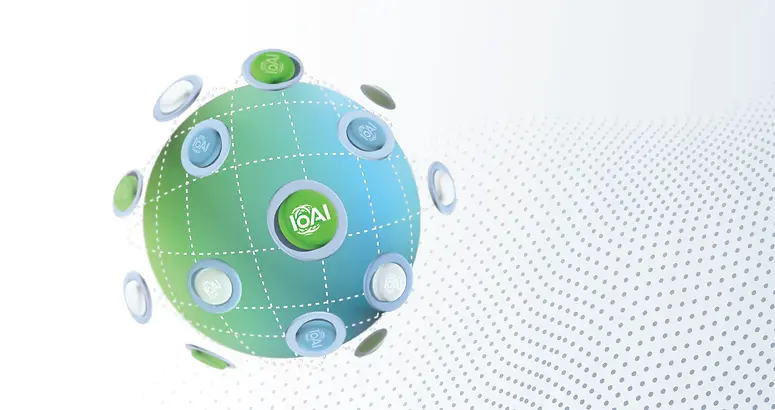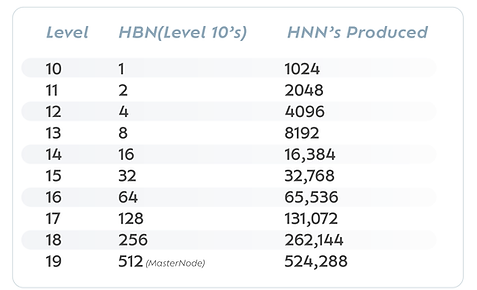
August 14, 2025
Article
HyperCycle Node Types and Roles for the IoAI
Introduction
The Internet of AI (IoAI) is an open, global network for multi-agent systems, accessible for every homo-sapien and AI without exception. HyperCycle develops the peer-to-peer network infrastructure that enables the IoAI, making it secure and scalable for AI. HyperCycle has two main node types, HyperCycle Network Nodes (HNNs) and HyperCycle Boundary Nodes (HBNs), each with roles. Knowing how these nodes work, how HyperCycle’s proof-of-n²-work unlocks more nodes and how to produce them through a Node Factory (NF) or Advanced Node Factory Enclosure (ANFE) demonstrates how HyperCycle helps facilitate the IoAI’s emerging AI agent marketplace.

HyperCycle Network Nodes (HNNs):
The Neurons of the IoAI
Network Nodes, or HNNs, are the main workers in HyperCycle’s network for the IoAI. They use a Network Node Licence to run the full HyperCycle Node Software, which includes:
-
Virtual Machine (VM): The space for doing tasks.
-
Transaction Machines (TMs): Handles fast, secure micropayments.
-
AI Machines (AIMs): For AI Agents and models.
-
Node Manager (NM): Keeps tasks running smoothly.
-
Merkle Module: Makes sure transactions and records are secure.
The VM, AIMs, TMs, NM, and Merkle Module work together for easy interactions in peer-to-peer computational marketplaces.

HNNs facilitate HyperCycle’s peer-to-peer network for multi-agent systems, executing and requesting tasks while securely handling micropayments. Their main jobs are:
-
Running Tasks: HNNs facilitate AI and other work, using TMs for secure payments.
-
Full Software Use: The VM, AIMs, TMs, NM, and Merkle Module work together for easy interactions.
-
Proving Performance with Proof-of-n² Work: HNNs are kept honest through real work on the IoAI, failing to complete tasks will damage their reputation, successfully completing tasks will see them chosen for more work.
-
Secure Records: They make records of work and payments, keeping the network secure.
HNNs are the core of HyperCycle’s network, facilitating the compute and securing the payment tools that will drive the IoAI’s global AI market.
HyperCycle Boundary Nodes (HBNs): Linking the IoAI
Boundary Nodes, or HBNs, connect HyperCycle’s network to traditional payment systems and external AI frameworks like Google A2A or Microsoft NL, interoperating across the IoAI. They are a Level 10 Node Factory Licence and run a simpler version of the HyperCycle software, without Transaction Machines. Their key jobs are:
-
Connecting Systems: HBNs link off-network payments (like traditional finance) with HyperCycle’s computing for the IoAI.
-
Uptime Tilling: HBNs must maintain uptime, a process known as tilling, this lets the IoAI know they are alive and ready for business. This proof unlocks the first Network Node Licences in their Node Factory.
-
Upgrading to Network Nodes: After unlocking the first Network Node Licences, a HBN can become a full HNN by earning USD 64 in verified revenue. This allows it to use TMs for micropayments in the IoAI.
HBNs focus on linking the Node Factory to external systems and tiling to unlock more Network Node Licences, helping HyperCycle’s network support an open IoAI where different platforms can work together.
Getting Nodes: Node Factory and ANFE
To participate in the IoAI, users can set up a HyperCycle Node Factory (NF) or purchase an Advanced Node Factory Enclosure (ANFE). Both options are suitable for users with varying technical skills from novice to expert.
-
Node Factory (NF): The Node Factory produces 1024 HNN’s per level 10 HBN through real work on the IoAI.
-
Advanced Node Factory Enclosure (ANFE): The ANFE is purchased as a ready-to-use package. In addition to producing HNN’s the ANFE can also produce any add on packaged software and AI Agents placed into the ANFE.
Both NF and ANFE contain varying amounts of level 10’s (HBNs), depending on size purchased and can unlock access to further HNNs, depending on progress on HyperCycle’s network.
The proof-of-n²-work system ensures nodes prove their value through real work, unlocking more Network Node Licences and so expanding the NF/ANFE owners operations.

Why Boundary Nodes Matter
Boundary Nodes are vital links that let HyperCycle’s peer-to-peer network for multi-agent systems work with traditional payment systems and external AI, from the smallest AI agent to large AI frameworks supporting the IoAI’s open nature. They make hybrid workflows possible, so systems can use HyperCycle’s secure and efficient software for machine-to-machine transactions on the IoAI.
The benefit for AI Agents Deploying to the IoAI with NF/ANFE
HyperCycle supports a range of AI deployment scenarios for developers and businesses resulting in higher intelligence or new revenue streams for AI agents.
Conclusion: The IoAI’s Global Network
HyperCycle’s node system, HNNs and HBNs, create a secure, scalable and efficient network that supports the IoAI. Network Nodes handle computing and payments, while Boundary Nodes connect traditional systems to the IoAI. Utilising proof-of-n²-work to unlock more Network Node Licences and maintain the networks honesty and integrity and scale to the demand of the global AI economy. Whether through a custom-built Node Factory or a ready-to-use ANFE, users can access both node types inside these, moving from linking systems to fully joining the peer-to-peer network for multi-agent systems. HyperCycle nodes facilitate secure payments, offer new revenue streams and/or increase AI intelligence, supporting the IoAI’s global AI economy one node at a time.
FAQ:
Node Types and Roles for the Internet of AI (IoAI)
What is the Internet of AI (IoAI)?
The IoAI is an open, global network for multi-agent systems, accessible to all humans and AI, facilitated by HyperCycle’s secure, scalable peer-to-peer infrastructure.
What are HyperCycle Network Nodes (HNNs)?
HNNs are the core workers of HyperCycle’s network, running tasks, handling secure micropayments and powering AI work using a Virtual Machine, Transaction Machines, AI Machines, Node Manager and Merkle Module.
What do HNNs do?
HNNs facilitate AI tasks, process micropayments, maintain secure records and prove performance through proof-of-n² work to build reputation and secure more tasks.
What are HyperCycle Boundary Nodes (HBNs)?
HBNs connect HyperCycle’s network to traditional payment systems and external AI frameworks, running simpler software without Transaction Machines.
What are the key roles of HBNs?
HBNs link off-network payments to HyperCycle’s system, maintain uptime through tilling to unlock Network Node Licences and can upgrade to HNNs after earning USD 64 in verified revenue.
Why are Boundary Nodes important?
HBNs enable integration with external systems, supporting hybrid workflows and ensuring the IoAI’s open nature by connecting diverse AI platforms.
How can I get nodes?
Nodes can be obtained by setting up a HyperCycle Node Factory (NF) or purchasing an Advanced Node Factory Enclosure (ANFE), both suitable for all skill levels.
What is a Node Factory (NF)?
An NF is a setup that produces 1024 HNNs per Level 10 HBN through real work on the IoAI. Setup guides and support are available online.
What is an Advanced Node Factory Enclosure (ANFE)?
An ANFE is a ready-to-use package that produces HNNs and supports add-on software and AI agents.
How does proof-of-n² work function?
Proof-of-n² work ensures nodes prove their value through real tasks, unlocking more Network Node Licences and maintaining network honesty and scalability.
How do HNNs and HBNs support the IoAI?
HNNs handle computing and payments, while HBNs connect external systems, together creating a secure, scalable network for the IoAI’s global AI economy.
What is the benefit for AI Agents Deploying to the IoAI with NF/ANFE?
Higher intelligence or new revenue streams.
Where can I find more information?
